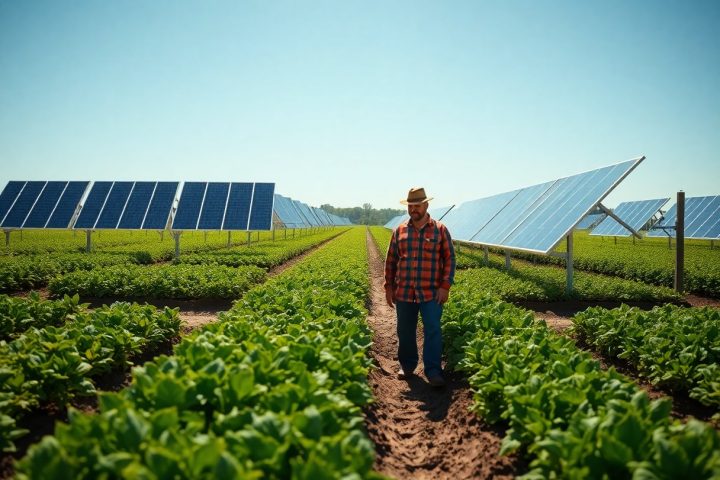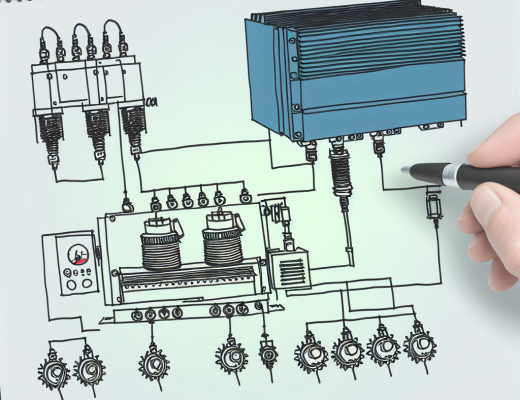Over the past decade, the integration of solar energy in agriculture has emerged as a transformative approach to sustainable farming. By harnessing the power of the sun through agrivoltaics, you can optimize land usage while enhancing crop yields. This innovative method involves the simultaneous use of land for both solar energy production and agricultural activities, providing you with a dual source of income. In this blog post, you will discover how agrivoltaics work, the benefits they offer to farmers, and the future potential of solar energy in agriculture.
Understanding Solar Energy
As you explore the world of solar energy, you’ll discover its potential to transform various industries. Harnessing sunlight for electricity or heat can significantly reduce reliance on fossil fuels, leading to a more sustainable future. By implementing solar technologies, you can tap into a clean, renewable energy source that has far-reaching benefits for both the environment and economic systems.
Fundamentals of Solar Energy
Before delving into solar energy’s applications, it’s vital to grasp the basics. Solar energy is derived from the sun’s radiation, which can be converted into usable energy through photovoltaic cells or solar thermal systems. This process involves absorbing sunlight and transforming it into electricity or heat, enabling you to power your home, business, or agricultural operations.
Benefits of Solar Energy in Agriculture
At its core, solar energy offers numerous advantages for agricultural practices. By integrating solar solutions into your farming methods, you can enhance productivity, lower operational costs, and promote environmental sustainability. Additionally, solar energy reduces greenhouse gas emissions and helps you maintain a competitive edge in the market.
But the benefits of solar energy in agriculture go beyond cost savings and environmental impact. By utilizing solar-powered systems for irrigation, crop monitoring, and energy needs, you can improve efficiency and yield. Moreover, combining solar installations with agricultural land—through agrivoltaics—allows for dual land use, enabling you to cultivate crops while generating renewable energy, thus maximizing your land’s potential and increasing your overall profitability.
Agrivoltaics Explained
While solar energy has transformed the way we harness power, agrivoltaics merges this technology with agriculture, offering a sustainable method of land use. This innovative approach allows farmers to cultivate crops while generating solar energy, ensuring beneficial coexistence between food production and renewable power. By utilizing shared land, agrivoltaics maximizes resource efficiency and contributes to energy independence.
Definition and Principles of Agrivoltaics
About agrivoltaics refers to the simultaneous use of land for both agriculture and solar energy production. This practice operates on the principle that solar panels can generate electricity while the land underneath remains viable for farming activities. By optimizing land use, agrivoltaics enhances food security and reduces dependency on fossil fuels.
Types of Agrivoltaic Systems
Against various types of agrivoltaic systems cater to different agricultural needs and solar power applications, each with unique designs and benefits:
| Type | Description |
| Fixed Tilt Systems | Static solar panels positioned above crops. |
| Tracking Systems | Solar panels that follow the sun’s path for optimal exposure. |
| Vertical Systems | Panels installed vertically, maximizing space in urban areas. |
| Floating Solar | Solar panels set on bodies of water, preserving land use. |
| Integrated Systems | Panels integrated into existing infrastructure, enhancing efficiencies. |
Any of these systems can be integrated based on specific agricultural practices and site conditions to achieve optimal energy production and crop yield.
And understanding the different types of agrivoltaic systems is necessary for making informed decisions about implementation. Depending on your land topography and crop type, you may find advantages in the flexibility offered by each system:
| System Advantages | Considerations |
| Fixed Tilt | Simple installation and maintenance. |
| Tracking | Higher energy yields compared to fixed systems. |
| Vertical | Suitable for urban settings and small spaces. |
| Floating | Reduces water evaporation while generating energy. |
| Integrated | Utilizes existing structures, reducing land footprint. |
Any of these types can help you achieve sustainable energy generation while maintaining productive agricultural practices.
Advantages of Agrivoltaics for Farmers
Even as climate challenges rise, agrivoltaics offer farmers a unique opportunity to enhance productivity while generating renewable energy. By integrating solar panels with agricultural practices, you can optimize land use, boost crop resilience, and reduce water dependence, creating a sustainable farming model that supports your livelihood and the environment.
Increased Crop Yield
Below the solar panels, crops can thrive in a microclimate created by the structure, which often leads to improved growing conditions. The shade reduces heat stress and preserves soil moisture, allowing you to enjoy higher crop yields while minimizing the environmental impact.
Economic Benefits and Sustainability
Besides boosting yields, agrivoltaics can provide significant economic advantages. By diversifying your income streams through energy production, you can enhance your farm’s financial resilience while contributing to the sustainable energy landscape.
And, by harnessing solar energy, you can lower your electricity costs and potentially gain additional revenue from selling excess energy back to the grid. This dual-income potential can greatly enhance your farm’s profitability, creating a more stable economic framework that supports long-term sustainability in agriculture. Furthermore, the reduction in water usage and pest pressures promotes not only a healthier ecosystem but also cultivates a more sustainable approach to farming.
Challenges and Considerations
Your journey into agrivoltaics may encounter several challenges, such as initial investment costs, land use implications, and environmental considerations. Understanding these factors is necessary for making informed decisions that can enhance both agricultural productivity and energy generation while addressing potential drawbacks effectively.
Initial Investment and Infrastructure
Along with the potential benefits, installing solar panels on agricultural land requires a significant upfront investment. This includes costs associated with solar equipment, installation, and modifications to existing farming practices. Evaluating your long-term financial viability and available funding options is key before committing to such an innovative approach.
Land Use and Environmental Concerns
Infrastructure development for agrivoltaics can raise questions about land use and its environmental impact. Balancing the need for energy generation with preserving local ecosystems and agricultural land usage is vital.
For instance, implementing solar systems may require clearing or modifying land, which could disrupt native habitats and biodiversity. Additionally, you must consider the implications of shading crops and how it could affect their growth cycles. Assessing the trade-offs between renewable energy generation and maintaining ecological balance will be important for your agrivoltaics project to succeed sustainably.
Case Studies and Success Stories
Unlike conventional farming methods, agrivoltaics has shown remarkable success in integrating solar energy with agriculture. Here are some noteworthy case studies demonstrating the effectiveness of this approach:
- Tohoku University, Japan – A pilot project increased crop yield by 20% while generating 300 kWh of energy per month.
- Freiburg, Germany – Over 200 hectares of solar panels created a 35% increase in berry crop production.
- California’s Coachella Valley – Agrivoltaics led to a 15% reduction in water usage for growing crops.
- University of Massachusetts – Solar installations improved soil moisture retention by 25% over traditional farming.
Global Examples of Agrivoltaics
An increasing number of countries are implementing agrivoltaic systems, proving the versatility and benefits of this technology. In France, agrivoltaic systems have been installed on vineyards, leading to a reported 40% improvement in grape quality and quantity. Meanwhile, Australia has adopted similar strategies, combining sheep grazing with solar energy production, resulting in a dual-use system that enhances land productivity.
Lessons Learned from Implementations
One key takeaway from agrivoltaic projects is the importance of site selection and design. Assessing land quality and solar exposure upfront can significantly affect your outcomes and yield. Collaboration with agricultural experts ensures the systems are optimized to enhance both crop production and energy generation.
And as these projects continue to grow, additional lessons are emerging. You may find that ongoing monitoring and maintenance are vital for maximizing efficiency and productivity. Additionally, adeptly managing the balance between solar panel placement and crop needs can lead to innovation in sustainable farming techniques. Adapting to local conditions and continuously learning from each implementation will empower you to optimize your agrivoltaic projects for long-term success.
Future Trends in Agrivoltaics
To navigate the future of agrivoltaics, you can expect innovative approaches that blend solar energy generation with crop production. As technology and environmental needs converge, new designs and practices will likely emerge, enhancing the efficiency and effectiveness of land use. This synergy will offer sustainable solutions to tackle climate challenges while boosting agricultural productivity.
Technological Advances
On the horizon, agrivoltaics will benefit from cutting-edge technologies such as vertical farming and smart sensors. These advancements will allow you to optimize crop yields while monitoring solar energy generation seamlessly. Enhanced materials and engineering techniques will also enable the development of more efficient and durable solar installations, making agrivoltaics even more viable for your agricultural practices.
Policy and Regulatory Support
For agrivoltaics to thrive, supportive policies and regulations are important. These frameworks will guide you in integrating solar energy technologies within agricultural systems, reducing barriers to adoption. You can anticipate a growing recognition among policymakers of the benefits of agrivoltaics, leading to incentives and funding opportunities that can ease your transition to sustainable practices.
A proactive policy landscape can provide you with necessary guidance and resources in your agrivoltaic endeavors. As regulations adapt, you may find grants, tax credits, and other financial incentives that can offset initial costs and enhance the attractiveness of this dual-use approach to land management. Continuous engagement with local and federal initiatives will be vital for you to maximize the advantages of agrivoltaics in your operations.
Final Words
With these considerations, you can see how agrivoltaics shape the future of agriculture by leveraging solar energy to enhance productivity while promoting sustainability. By integrating solar panels with crop production, you ensure not only a supplementary income through energy generation but also improve land efficiency. This dual-use approach allows you to cultivate your crops while generating clean, renewable energy, making a positive impact on your farm’s ecological footprint. As you explore this innovative strategy, you’ll find that agrivoltaics can transform challenges into opportunities in your agricultural practices.




